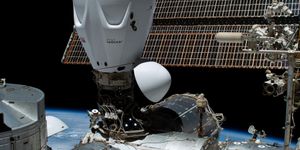NASA InSight Lander's Lasting Impact: New Understanding of Mars' Rotation
While the batteries on NASA’s InSight lander officially ran out of juice in December 2022, scientists are still pouring over the droves of radio science data sent back to Earth from the brave robotic explorer. Now, scientists have successfully used that data to not only ascertain key characteristics of Mars’ atmosphere, mantle, and core, but they’ve also produced some of the most accurate measurements of the Red Planet’s rotation. The results were recently published in the journal Nature and hold the potential to help scientists better understand the formation and evolution of our nearest planetary neighbor, and one of the most intriguing planetary bodies in the solar system.
Selfie from NASA’s InSight lander taken on April 24, 2022, the 1,211th Martian day, or sol, of the mission. Accumulating dust on the lander’s solar panels caused its batteries to slowly lose power, resulting in the lander going dark in December 2022. However, data obtained from InSight’s instruments is still being analyzed, including this most recent study regarding the core and wobble of Mars. (Credit: NASA/JPL-Caltech)
Using data obtained from InSight’s Rotation Interior Structure Experiment (RISE), scientists were not only able to calculate that Mars’ rotation is accelerating, but the total length of one Martian day, known as a Sol, is decreasing by a fraction of a millisecond per year. However, questions remain as to the cause of the rotational acceleration, with several hypotheses currently being suggested, including rising landmasses after recently being unburied from ice, and the latter of which is presently accumulating at the planet’s polar caps.
“It’s really cool to be able to get this latest measurement – and so precisely,” said Dr. Bruce Banerdt, who is InSight’s principal investigator at NASA’s Jet Propulsion Laboratory, and a co-author on the study. “I’ve been involved in efforts to get a geophysical station like InSight onto Mars for a long time, and results like this make all those decades of work worth it.”
The reason this ice accumulation/rising landmass process is occurring is due to Mars’ unstable axial tilt, which wobbles uncontrollably over the course of hundreds of thousands to millions of years. Unlike Earth, whose axis currently sits at 23.4 degrees and slightly wobbles like a spinning top between 22.1 and 24.5 degrees due to the gravitational stability from our Moon, Mars lacks such stability despite it having two moons, as both are smaller than ours. While the axial tilt of Mars is currently at 25.1 degrees, it has a much larger range than Earth, going as low as 15 degrees ad reaching as high as 45 degrees. These extreme tilt variations result in extreme climate variation all over the planet, which leads to ice shifting from the poles to the equator then back to the poles. Currently, ice is receding to the poles as its axial tilt increases, which causes landmasses to rise and ice accumulation at the poles.
Using data from RISE, the researchers determined the liquid core of Mars is not only sloshing, but that it has a radius of approximately 1,140 miles (1,835 kilometers). It is also because of this sloshing that the researchers were able to accurately measure the wobble of Mars, also called its nutation. Combining this data with previous seismic data obtained by InSight, the team pull a more estimated measurement of the radius of Mars’ core at between 1,112 miles and 1,150 miles (1,790 and 1,850 kilometers). For context, this is less than half the estimated radius of Earth’s core, which currently stands at 2,165 miles (3,485 kilometers). The radius for the entire Red Planet is currently estimated at 2,106 miles (3,390 kilometers), with Earth’s at 3,959 miles (6,371 kilometers), or just greater than half the size of Earth.
Along with providing estimations about the core radius of Mars, details of the core’s shape can also be ascertained from these measurements, as well.
“RISE’s data indicate the core’s shape cannot be explained by its rotation alone,” said Dr. Attilio Rivoldini, who is a planetary scientist at the Royal Observatory of Belgium, and a co-author on the study. “That shape requires regions of slightly higher or lower density buried deep within the mantle.”
The data from InSight will keep scientists busy for the next several years, but this study served as a curtain call for InSight principal investigator, Dr. Banerdt, who retired on August 1 after serving an astounding 46 years at NASA’s Jet Propulsion Laboratory.
What new discoveries about Mars and its core will scientists unveil using data from InSight in the coming years and decades? Only time will tell, and this is why we science!
As always, keep doing science & keep looking up!
Sources: NASA, Nature, NASA (1), NASA (2), NASA (3), NASA JPL, National Geographic









